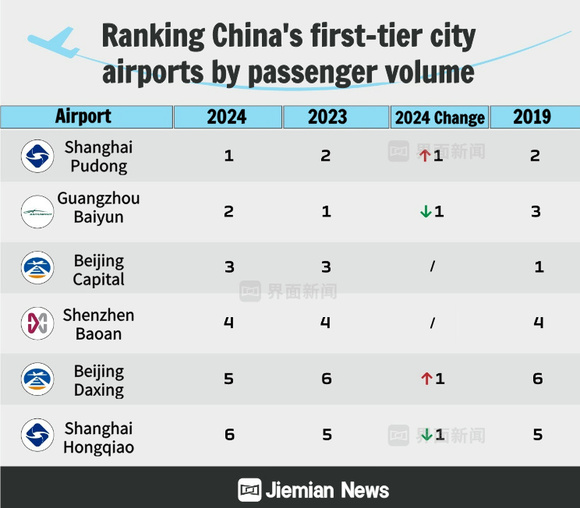The robust recovery in 2024 was driven by record passenger numbers on domestic routes. Domestic airlines transported over 700 million passengers in 2024, surpassing 2019 levels by 10.7%.

by Xue Bingbing
As 2024 drew to a close and 2025 began, China's major airports unveiled their annual passenger throughput reports, revealing a stunning recovery in air travel. While 2023 marked the beginning of a rebound, 2024 saw these airports soaring past pre-pandemic levels, signaling a resurgent civil aviation market.
Among the first-tier cities, Beijing and Shanghai both had two international airports. According to data from Capital Airport Group, Beijing Capital Airport and Beijing Daxing Airport collectively handled 117 million passengers in 2024, representing a year-on-year increase of 26.2% and a 12.9% rise compared to 2019. Similarly, Shanghai Pudong and Shanghai Hongqiao airports achieved a combined passenger throughput of over 124 million, marking a 29% year-on-year growth and setting a new record.
In Guangzhou and Shenzhen, passenger numbers also reached unprecedented levels. Guangzhou Baiyun Airport handled 76.37 million passengers, up 20.89% from the previous year and surpassing its pre-pandemic peak of 70 million. Shenzhen Baoan Airport crossed the 60 million milestone for the first time, recording 61.48 million passengers.

The pandemic caused a significant reshuffling of airport rankings in Beijing, Shanghai, Guangzhou, and Shenzhen due to varying recovery rates for domestic and international routes. While Guangzhou Baiyun Airport led the nation in passenger throughput for four consecutive years during the pandemic, the landscape shifted in 2024. Shanghai Pudong Airport reclaimed the top spot, narrowly surpassing Baiyun Airport with an estimated 76.79 million passengers.
Beijing’s two airports continued to face challenges. Although Beijing Capital Airport handled over 100 million passengers annually in 2018 and 2019, the diversion of traffic to the newer Daxing Airport has made it unlikely to regain its former peak. In 2024, Capital Airport’s recovery rate reached 67.38% of pre-pandemic levels, up from 52% in 2023.

The robust recovery in 2024 was driven by record passenger numbers on domestic routes. According to the Civil Aviation Administration of China, domestic airlines transported over 700 million passengers in 2024, surpassing 2019 levels by 10.7%. International routes also began to recover, particularly benefiting airports with a high volume of inbound and outbound passengers.
Shanghai Pudong Airport's leadership is attributed to the resumption of international flights and the city's role as a major international gateway. In 2024, Pudong Airport added or restored seven international passenger routes, including Athens, Riyadh, and Manchester. The Shanghai Immigration Inspection Station reported 34 million inbound and outbound travelers at Shanghai’s airports, with almost 4 million foreign arrivals at Pudong Airport alone.
Airports with faster recovery in international routes stand to gain a competitive edge. Tax-free shop revenue, a critical income source for airports, depends heavily on international passenger traffic. Pudong Airport's financial performance reflects this advantage. Shanghai Airport Group posted a net profit of 1.202 billion yuan in the first three quarters of 2024, with tax-free revenue accounting for 76.12% of profits. In contrast, Capital Airport in Beijing remained in the red, with a net loss of 460 million yuan, though this was a marked improvement from the previous year.
The pace of international route recovery remains a key factor in future competition. As China continues to strengthen its role as an international aviation hub, airports in Beijing, Shanghai, Guangzhou, and Shenzhen must enhance intercontinental connectivity to attract more global travelers. Pudong Airport’s lead in restoring international routes highlights the importance of strategic route planning and infrastructure investment in securing long-term growth.